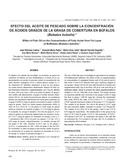| dc.rights.license | http://creativecommons.org/licenses/by-nc-sa/3.0/ve/ | |
| dc.contributor.author | Cedres, José Feliciano | |
| dc.contributor.author | María Patiño, Exequiel | |
| dc.contributor.author | Judis, María Alicia | |
| dc.contributor.author | Sánchez Negrette, Marcial | |
| dc.contributor.author | Romero, Ana María | |
| dc.contributor.author | Doval, Mirtha Marina | |
| dc.contributor.author | Rebak, Gladys Isabel | |
| dc.contributor.author | Crudeli, Gustavo Angel | |
| dc.date.accessioned | 2013-06-18T12:07:46Z | |
| dc.date.available | 2013-06-18T12:07:46Z | |
| dc.date.issued | 2013-06-18T12:07:46Z | |
| dc.identifier.issn | 0798-2259 | |
| dc.identifier.uri | http://www.saber.ula.ve/handle/123456789/37191 | |
| dc.description.abstract | El objetivo del estudio fue investigar en muestras de grasa de
cobertura de búfalos de raza Mediterránea, el efecto de la suplementación
con aceite de pescado sobre la concentración del
ácido linoleico conjugado (CLA) y ácidos grasos omega 6 y 3.
Se emplearon 20 animales separados al azar en dos grupos,
los cuales fueron alimentados diariamente durante 60 días sobre
Brachiaria brizantha y suplementados con 3 kg de afrecho
de arroz, 500 g de maíz y 500 g de pellet de girasol. El grupo I
solo recibió esta alimentación, el grupo II recibió además diariamente
100 mL. de aceite de pescado por animal. Los resultados
indican una importante disminución del ácido graso palmítico en
el grupo II (259,72 mg/g de grasa) en relación al grupo I (280,84
mg/g de grasa). Entre los ácidos grasos insaturados (AGI), el
valor de CLA (18:2) 9c 11t del grupo II (16,80 mg/g de grasa)
sufrió un aumento en relación al grupo I (11,75 mg/g de grasa).
El contenido de omega 6 (linoleico 18:2 n6) del grupo II (13,21
mg/g de grasa) se incrementó ligeramente con respecto al grupo
I (12,71 mg/g de grasa). El contenido de omega 3 (20:1c 11
+ eicosenoico alfa (18:3) n3) para los grupos I y II fue 4,70 y
6,05 mg/g de grasa, respectivamente. La relación omega 6/3
del grupo II fue más estrecha (2,18:1) que la del grupo I
(2,70:1). La proporción de AGI / AGS del grupo II fue de 0,67.
En conclusión, la dieta del grupo II que incluyó aceite de pescado,
incrementó en la grasa de cobertura el contenido de CLA y
de omega 3 y mejoró la relación omega 6 / 3. | es_VE |
| dc.language.iso | es | es_VE |
| dc.rights | info:eu-repo/semantics/openAccess | |
| dc.subject | Búfalos | es_VE |
| dc.subject | grasa de cobertura | es_VE |
| dc.subject | CLA | es_VE |
| dc.subject | Omega 6 y 3 | es_VE |
| dc.subject | aceite de pescado | es_VE |
| dc.title | Efecto del aceite de pescado sobre la concentración de ácidos grasos de la grasa de cobertura en búfalos (Bubalus bubalis) | es_VE |
| dc.title.alternative | Effect of Fish Oil on the Concentration of Fatty Acids from Fat Layer of Buffaloes (Bubalus bubalis) | es_VE |
| dc.type | info:eu-repo/semantics/article | |
| dc.description.abstract1 | The aim of this trial was to investigate in subcutaneus fat samples
of Mediterranean buffaloes, the effect of fish oil supplementation
on concentration of conjugated linoleic acid (CLA) and n6 and n3
fatty acids. A total of 20 animals were used, randomly asigned to
two groups. Group I fed for 60 days with Brachiaria brizantha and
supplemented with 3 kg of rice flour, 500 gr of corn and 500 gr of
sunflower pellets. Group II received the same supplementation in
addition to 100 mL. daily fish oil per animal. The results showed
an important palmitic acid decrease in the group II (259.72 mg/g
fat) than in group I (280.84 mg/g fat). Among the unsaturated
fatty acids (PUFA) the value of CLA (18:2) 9 c, 11 t of group II
(16.80 mg/g fat) increased relative in the group I (11.75 mg/g fat).
The content of n6 (linoleic 18:2 n6) in the group II (13.21 mg/g
fat) was increased slightly compared to group I (12.71mg/g fat).
The content of n3 (18:3) n3 in the groups I and II was 4.70 to
6.05 mg/g fat, respectively. The relation n6/n3 in the group II was
more (2.18:1) than in group I (4.70:1). The proportion of PUFA /
SFA group II was 0.67. In conclusion, the group II diet with fish
oil, increased the CLA content in fat layer and n3, in addition to
improving the n6/n3 relation. | es_VE |
| dc.description.email | cedres@vet.unne.edu.ar | es_VE |
| dc.description.frecuencia | Bimestral | |
| dc.identifier.depositolegal | 199102ZU46 | |
| dc.publisher.pais | Venezuela | es_VE |
| dc.subject.institucion | Universidad del Zulia (LUZ) | es_VE |
| dc.subject.institucion | Universidad de Los Andes (ULA) | es_VE |
| dc.subject.keywords | Buffaloes | es_VE |
| dc.subject.keywords | fat layer | es_VE |
| dc.subject.keywords | CLA | es_VE |
| dc.subject.keywords | Omega 6 and 3 | es_VE |
| dc.subject.keywords | fish oil | es_VE |
| dc.subject.publicacionelectronica | Revista Científica | |
| dc.subject.seccion | Revista Científica: Producción Animal | es_VE |
| dc.subject.thematiccategory | Medio Ambiente | es_VE |
| dc.subject.tipo | Revistas | es_VE |
| dc.type.media | Texto | es_VE |


